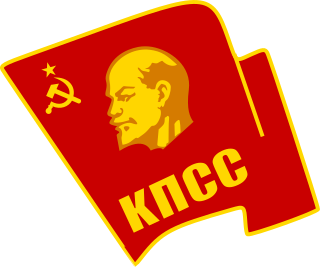
The Communist Party of the Soviet Union (CPSU), also known by various other names during its history, was the founding and ruling party of the Soviet Union. The CPSU was the sole governing party of the Soviet Union until 1990 when the Congress of People's Deputies modified Article 6 of the 1977 Soviet Constitution, which had previously granted the CPSU a monopoly over the political system. The party has its roots in the Russian Social Democratic Labour Party (RSDLP). The RSDLP was founded in 1898, when Russia was ruled by an absolute monarchy. The broad anti-Tsarist ideology was the driving factor in its initial growth. Russians across the political spectrum flocked to the party, as Marxists, socialists, and centrists made up its ranks. Despite the Tsar's harsh oppression including imprisoning and even executing party members, the RSDLP continued to grow, albeit underground. Initially the party operated in a unified and cohesive manner, but by 1900 cracks within party unity began to show.

Leninism is a political ideology developed by Russian Marxist revolutionary Vladimir Lenin that proposes the establishment of the dictatorship of the proletariat led by a revolutionary vanguard party as the political prelude to the establishment of communism. The function of the Leninist vanguard party is to provide the working classes with the political consciousness and revolutionary leadership necessary to depose capitalism in the Russian Empire (1721–1917). Leninist revolutionary leadership is based upon The Communist Manifesto (1848), identifying the communist party as "the most advanced and resolute section of the working class parties of every country; that section which pushes forward all others." As the vanguard party, the Bolsheviks viewed history through the theoretical framework of dialectical materialism, which sanctioned political commitment to the successful overthrow of capitalism, and then to instituting socialism; and, as the revolutionary national government, to realise the socio-economic transition by all means.
Marxism–Leninism is a communist ideology that was the main communist movement throughout the 20th century. Developed by the Bolsheviks, it was the state ideology of the Soviet Union, Soviet satellite states in the Eastern Bloc, and various countries in the Non-Aligned Movement and Third World during the Cold War, as well as the Communist International after Bolshevisation. Today, Marxism–Leninism is the ideology of the ruling parties of China, Cuba, Laos and Vietnam, as well as many other Communist parties, while the state ideology of North Korea is derived from Marxism–Leninism. Marxist–Leninist states are commonly referred to as "communist states" by Western academics. Marxist–Leninists reject anarchism and left communism, as well as reformist socialism and social democracy. They oppose fascism, imperialism, and liberal democracy. Marxism–Leninism holds that a two-stage communist revolution is needed to replace capitalism. A vanguard party, organized through democratic centralism, would seize power on behalf of the proletariat and establish a one-party socialist state, called the dictatorship of the proletariat. The state would control the means of production, suppress opposition, counter-revolution, and the bourgeoisie, and promote Soviet collectivism, to pave the way for an eventual communist society that would be classless and stateless.
The nomenklatura were a category of people within the Soviet Union and other Eastern Bloc countries who held various key administrative positions in the bureaucracy, running all spheres of those countries' activity: government, industry, agriculture, education, etc., whose positions were granted only with approval by the communist party of each country or region.

The Russian Revolution was a period of political and social revolution that took place in the former Russian Empire which began during the First World War. This period saw Russia abolish its monarchy and adopt a socialist form of government following two successive revolutions and a bloody civil war. The Russian Revolution can also be seen as the precursor for the other European revolutions that occurred during or in the aftermath of WWI, such as the German Revolution of 1918.

Trotskyism is the political ideology and branch of Marxism developed by Ukrainian-Russian revolutionary Leon Trotsky and some other members of the Left Opposition and Fourth International. Trotsky described himself as an orthodox Marxist, a revolutionary Marxist, and Bolshevik–Leninist, a follower of Marx, Engels, and 3L: Vladimir Lenin, Karl Liebknecht, and Rosa Luxemburg. He supported founding a vanguard party of the proletariat, proletarian internationalism, and a dictatorship of the proletariat based on working-class self-emancipation and mass democracy. Trotskyists are critical of Stalinism as they oppose Joseph Stalin's theory of socialism in one country in favour of Trotsky's theory of permanent revolution. Trotskyists criticize the bureaucracy and anti-democratic current developed in the Soviet Union under Stalin.
The ten years 1917–1927 saw a radical transformation of the Russian Empire into a socialist state, the Soviet Union. Soviet Russia covers 1917–1922 and Soviet Union covers the years 1922 to 1991. After the Russian Civil War (1917–1923), the Bolsheviks took control. They were dedicated to a version of Marxism developed by Vladimir Lenin. It promised the workers would rise, destroy capitalism, and create a socialist society under the leadership of the Communist Party of the Soviet Union. The awkward problem was the small proletariat, in an overwhelmingly peasant society with limited industry and a very small middle class. Following the February Revolution in 1917 that deposed Nicholas II of Russia, a short-lived provisional government gave way to Bolsheviks in the October Revolution. The Bolshevik Party was renamed the Russian Communist Party (RCP).

Bolshevism is a revolutionary socialist current of Soviet Marxist–Leninist political thought and political regime associated with the formation of a rigidly centralized, cohesive and disciplined party of social revolution, focused on overthrowing the existing capitalist state system, seizing power and establishing the "dictatorship of the proletariat".

The Communist International (Comintern), also known as the Third International, was a Soviet-controlled international organization founded in 1919 that advocated world communism. The Comintern resolved at its Second Congress to "struggle by all available means, including armed force, for the overthrow of the international bourgeoisie and the creation of an international Soviet republic as a transition stage to the complete abolition of the state". The Comintern was preceded by the 1916 dissolution of the Second International.

The Workers' Opposition was a faction of the Russian Communist Party that emerged in 1920 as a response to the perceived over-bureaucratisation that was occurring in Soviet Russia. They advocated the transfer of national economic management to trade unions. The group was led by Alexander Shlyapnikov, Sergei Medvedev, Alexandra Kollontai and Yuri Lutovinov. It officially existed until March 1921 when it was forced to dissolve by the 10th Congress of the Russian Communist Party (Bolsheviks), and semi-clandestinely until the subsequent 11th Congress in 1922, where its main exponents teetered dangerously on the verge of being purged for fractionist activity. In some aspects, it was close with the German council communist movement, although there is no information about direct contacts between these groups.
The history of the Communist Party of the Soviet Union was generally perceived as covering that of the Bolshevik faction of the Russian Social Democratic Labour Party from which it evolved. The date 1912 is often identified as the time of the formation of the Communist Party of the Soviet Union as a distinct party, and its history since then can roughly be divided into the following periods:
Dmitri Antonovich Volkogonov was a Soviet and Russian historian and colonel general who was head of the Soviet military's psychological warfare department. After research in secret Soviet archives, he published biographies of Joseph Stalin and Vladimir Lenin, among others. Despite being a committed Stalinist and Marxist–Leninist ideologue for most of his career, Volkogonov came to repudiate communism and the Soviet system within the last decade of his life before his death from cancer in 1995.

Vladimir Ilyich Ulyanov, better known as Vladimir Lenin, was a Russian revolutionary, politician, and political theorist. He served as the first and founding head of government of Soviet Russia from 1917 to 1924 and of the Soviet Union from 1922 to 1924. Under his administration, Russia, and later the Soviet Union, became a one-party socialist state governed by the Communist Party. Ideologically a Marxist, his developments to the ideology are called Leninism.
The ideology of the Communist Party of the Soviet Union (CPSU) was Bolshevist Marxism–Leninism, an ideology of a centralised command economy with a vanguardist one-party state to realise the dictatorship of the proletariat. The Soviet Union's ideological commitment to achieving communism included the development of socialism in one country and peaceful coexistence with capitalist countries while engaging in anti-imperialism to defend the international proletariat, combat capitalism and promote the goals of communism. The state ideology of the Soviet Union—and thus Marxism–Leninism—derived and developed from the theories, policies and political praxis of Lenin and Stalin.
In Russia, efforts to build communism began after Tsar Nicholas II lost his power during the February Revolution, which started in 1917, and ended with the dissolution of the USSR in 1991. The Provisional Government was established under the liberal and social-democratic government; however, the Bolsheviks refused to accept the government and revolted in October 1917, taking control of Russia. Vladimir Lenin, their leader, rose to power and governed between 1917 and 1924.

The All-Union Leninist Young Communist League, usually known as Komsomol, a syllabic abbreviation of the Russian Коммунистический Союз Молодёжи, was a political youth organization in the Soviet Union. It is sometimes described as the youth division of the Communist Party of the Soviet Union (CPSU), although it was officially independent and referred to as "the helper and the reserve of the CPSU".
The New Economic Policy (NEP) was an economic policy of the Soviet Union proposed by Vladimir Lenin in 1921 as a temporary expedient. Lenin characterized the NEP in 1922 as an economic system that would include "a free market and capitalism, both subject to state control", while socialized state enterprises would operate on "a profit basis".
Anti-revisionism is a position within Marxism–Leninism which emerged in the 1950s in opposition to the reforms of Soviet leader Nikita Khrushchev. Where Khrushchev pursued an interpretation that differed from his predecessor Joseph Stalin, the anti-revisionists within the international communist movement remained dedicated to Stalin's ideological legacy and criticized the Soviet Union under Khrushchev and his successors as state capitalist and social imperialist.
Soviet democracy, or council democracy, is a political system in which the rule of the population is exercised by directly elected soviets. The councils are directly responsible to their electors and bound by their instructions using a delegate model of representation. Such an imperative mandate is in contrast to a free mandate, in which the elected delegates are only responsible to their conscience. Delegates may accordingly be dismissed from their post at any time or be voted out (recall).
Under the leadership of Russian communist Vladimir Lenin, the Bolshevik Party seized power in the Russian Republic during a coup known as the October Revolution. Overthrowing the pre-existing Provisional Government, the Bolsheviks established a new administration, the first Council of People's Commissars, with Lenin appointed as its governing chairman. Ruling by decree, Lenin’s Sovnarkom introduced widespread reforms confiscating land for redistribution among the permitting non-Russian nations to declare themselves independent, improving labour rights, and increasing access to education.









